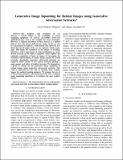Files in this item
Generative image inpainting for retinal images using generative adversarial networks
Item metadata
| dc.contributor.author | Magister, Lucie Charlotte | |
| dc.contributor.author | Arandjelovic, Ognjen | |
| dc.date.accessioned | 2022-01-25T16:30:03Z | |
| dc.date.available | 2022-01-25T16:30:03Z | |
| dc.date.issued | 2021-12-09 | |
| dc.identifier | 277509039 | |
| dc.identifier | 3c7811fc-aa18-4b02-82e5-ee27859b7834 | |
| dc.identifier | 85122022316 | |
| dc.identifier | 34891838 | |
| dc.identifier | 000760910502168 | |
| dc.identifier.citation | Magister , L C & Arandjelovic , O 2021 , Generative image inpainting for retinal images using generative adversarial networks . in 2021 43rd Annual International Conference of the IEEE Engineering in Medicine & Biology Society (EMBC) . vol. 2021 , Annual International Conference of the IEEE Engineering in Medicine and Biology Society. IEEE Engineering in Medicine and Biology Society. Annual International Conference , IEEE , pp. 2835-2838 . https://doi.org/10.1109/EMBC46164.2021.9630619 | en |
| dc.identifier.issn | 2375-7477 | |
| dc.identifier.uri | https://hdl.handle.net/10023/24745 | |
| dc.description.abstract | The diagnosis and treatment of eye diseases is heavily reliant on the availability of retinal imagining equipment. To increase accessibility, lower-cost ophthalmoscopes, such as the Arclight, have been developed. However, a common drawback of these devices is a limited field of view. The narrow-field-of-view images of the eye can be concatenated to replicate a wide field of view. However, it is likely that not all angles of the eye are captured, which creates gaps. This limits the usefulness of the images in teaching, wherefore, artist's impressions of retinal pathologies are used. Recent research in the field of computer vision explores the automatic completion of holes in images by leveraging the structural understanding of similar images gained by neural networks. Specifically, generative adversarial networks are explored, which consist of two neural networks playing a game against each other to facilitate learning. We demonstrate a proof of concept for the generative image inpainting of retinal images using generative adversarial networks. Our work is motivated by the aim of devising more realistic images for medical teaching purposes. We propose the use of a Wasserstein generative adversarial network with a semantic image inpainting algorithm, as it produces the most realistic images.Clinical relevance- The research shows the use of generative adversarial networks in generating realistic training images. | |
| dc.format.extent | 4 | |
| dc.format.extent | 2399932 | |
| dc.language.iso | eng | |
| dc.publisher | IEEE | |
| dc.relation.ispartof | 2021 43rd Annual International Conference of the IEEE Engineering in Medicine & Biology Society (EMBC) | en |
| dc.relation.ispartofseries | Annual International Conference of the IEEE Engineering in Medicine and Biology Society. IEEE Engineering in Medicine and Biology Society. Annual International Conference | en |
| dc.subject | LB2300 Higher Education | en |
| dc.subject | QA75 Electronic computers. Computer science | en |
| dc.subject | QA76 Computer software | en |
| dc.subject | RE Ophthalmology | en |
| dc.subject | Medicine(all) | en |
| dc.subject | AC | en |
| dc.subject.lcc | LB2300 | en |
| dc.subject.lcc | QA75 | en |
| dc.subject.lcc | QA76 | en |
| dc.subject.lcc | RE | en |
| dc.title | Generative image inpainting for retinal images using generative adversarial networks | en |
| dc.type | Book item | en |
| dc.contributor.institution | University of St Andrews. School of Computer Science | en |
| dc.identifier.doi | 10.1109/EMBC46164.2021.9630619 |
This item appears in the following Collection(s)
Items in the St Andrews Research Repository are protected by copyright, with all rights reserved, unless otherwise indicated.

